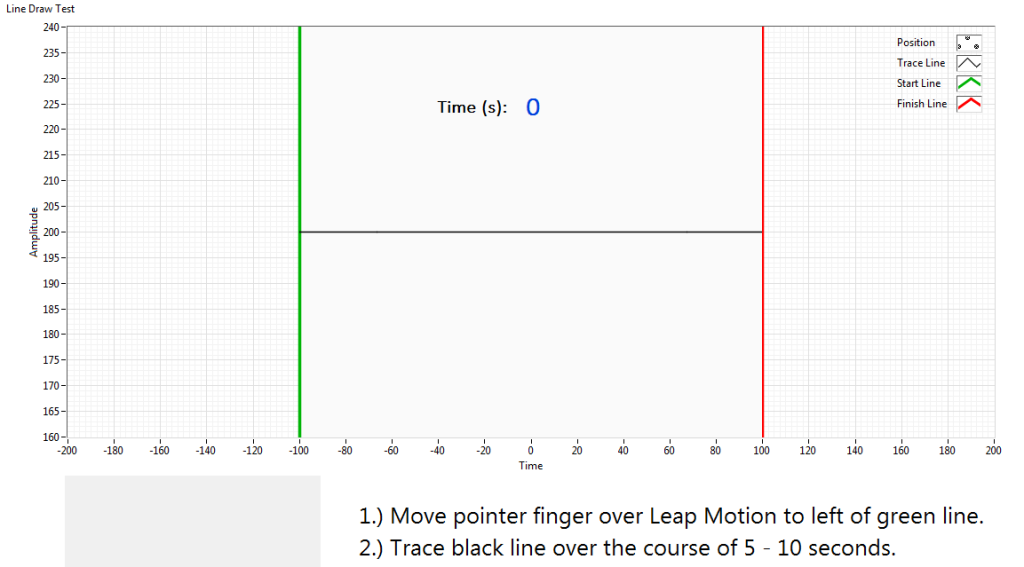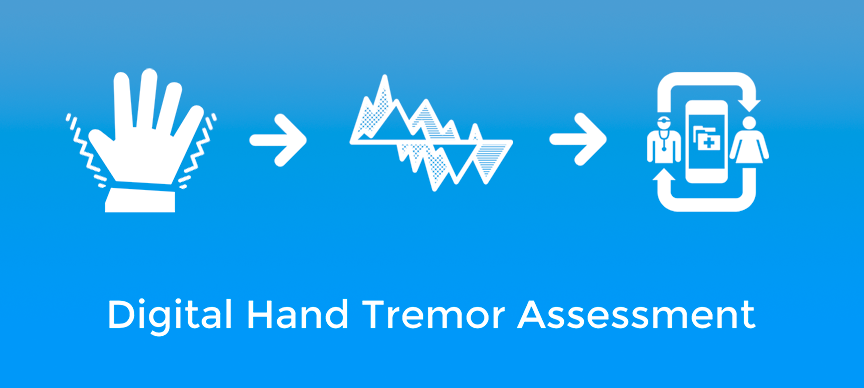Hand tremors from diseases such as essential tremor, Parkinson’s disease, Wilson’s disease, dystonia and others affect tens of millions of people around the world, and the neurological and genetic basis for many tremors is still yet to be understood. Patients suffer physically, often unable to write and practice art, as well as socially, with tremors giving rise to more social anxiety. Unfortunately, there are relatively few ways for individuals and doctors to quickly and reliably track tremor progression over time.
Recently, I met a neuroscientist named Marianne Stephans at a hackathon in San Francisco connecting people working in the neuroscience field with technologists. We worked together afterwards to build a movement sonification application – a method for giving sound feedback for physical movement, related to research she does connecting motor control and auditory memory/control. I found myself inspired by the problem set, given the number of people suffering from these types of motor control problems.
With better tremor measurement and tracking using Leap Motion, I believe research could progress faster aiding in the treatment of tremors and doctors could have a more efficient tool for quantifying tremor.
Current assessment tools
Most assessment is done manually, with tools that can be cumbersome and provide limited data for reliably quantifying tremor characteristics. These include accelerometers, graphic tablets, mechanical-linkages, and EMG sensors. Most require physically connecting devices to the patient, which can be time-consuming and expensive. Additionally, according to researchers at the Tremor Research Group in 2006:
Tremor rating scales (TRSs) are used commonly in the clinical assessment of tremor, but the relationship of a TRS to actual tremor amplitude has never been quantified. Consequently, the resolution of these scales is unknown, and the clinical significance of a 1-point change in TRS is uncertain.
This continues to be the case.
Measurement resolution
One of the first questions that came up was what sort of movement resolution and reliability was available using the Leap Motion Controller. Fortunately, a research group had done a study on an early developer device and its capabilities in early 2013. Using an industrial precision robotic arm, they found the resolution to be around .2 mm of movement and 1.2 mm after accounting for error. Additionally, the Leap Motion Controller specifies the frame rate at 290+ frames per second, giving plenty of updates for frequency analysis up to 145 Hz based on the Nyquist-Shannon theorem.
Pattern tracing and analysis
Now confident in the device’s capabilities, I set out to build a simple application to track movement over a given space and time. This materialized into a tool to mimic the assessment test used by many professionals, where a patient is asked to draw a pattern on a piece of paper. The pattern is then analyzed and compared to the model pattern to quantify tremor.
To do this, the patient is asked to trace a line on the screen with feedback on where the finger is. Once a line tracing is complete, the application calculates average position, deviation, variance, time, and other statistics. This could easily be applied to squares/circles or in three dimensions for more complex patterns like spirals.

One challenge with this approach was visually defining the location of the finger on the screen and how to start the acquisition. It made sense to show an entry and exit zone, so that the app could detect the finger entering the start line and start tracking from there. With a few modifications, the application could be made to track multiple iterations at once and quantify/average all tests.
Frequency analysis
Another important characteristic of hand tremor that clinicians care about is the movement frequency – so my second goal was to use the high-speed capabilities of the Leap Motion Controller to accurately measure hand tremor frequency. I built an application to record the movement data of a patient’s hand being held over the device and quantify the entire hand movement as well as individual digits. After a fixed amount of time, the data is analyzed for frequency components and other movement statistics.
What this means
Though these applications don’t actually solve the problem of tremors, they may be able to bring low-cost assessment to doctors and sufferers, yielding more data from which to analyze and generate solutions. They are simplified tests to demonstrate the concept of testing hand tremor with the device, but foundational in determining a path forward. With more data and a fixed testing procedure, highly accurate tremor analysis could help doctors and researchers find solutions to the problem of tremors. Additionally, a database of patient data could be established and more complex tests could be created to get more specific answers to neurologists’ questions.
Drawbacks
It’s limiting to only be able to use the technology for hand tremors, though future work will likely bring this approach to whole or specific body tracking. Another potential downside is the lack of tactile feedback during a test. Moving a hand in the air without experiencing pushback (such as a pen/paper interaction) may not provide for the best results. Further study is needed.
Feedback
I’m currently reaching out to neurologists and clinicians to gauge and calibrate the value of this application. What is your feedback? Do you know someone suffering from tremors or working in neurology? Would this be valuable for them? Please share and/or ask them what they’d think.




Hi Chris, We have been working in this field for a while, and we have developed one of the world first tremor analysis using markers motion sensors including LEAP sensor. We have submitted this work in 2011 to LEAP MOTION but I do not understand why they did not show it in their website.
See below for a link to our innovation, publications and some videos. We are now collecting mass data across Australia and possibly the world. If you wish to know more or collaborate please contact us or the office of Industry and Innovation at The University of Western Australia
http://people.csse.uwa.edu.au/~elsallam/Parkinson.html
July 1, 2014 at 6:57 pmHi Chris, We have been working in this field for a while, and we have developed one of the world first tremor analysis using markers motion sensors including LEAP sensor. We have submitted this work in 2011 to LEAP MOTION but I do not understand why they did not show it in their website.
See below for a link to our innovation, publications and some videos. We are now collecting mass data across Australia and possibly the world. If you wish to know more or collaborate please contact us or the office of Industry and Innovation at The University of Western Australia
http://people.csse.uwa.edu.au/~elsallam/Parkinson.html
July 1, 2014 at 7:40 pmCool Amar! I’ll take a look around your site. Interesting work
July 2, 2014 at 10:41 amThanks Chris, yours too !
btw we may start a major project in this field across Australia through UWA Crowd Research (http://crowdresearch.csp.uwa.edu.au/), will wait for some funding etc. outcomes and If there is any chance for us to collaborate or get you on board I will let you know.
July 2, 2014 at 6:27 pmExcellent idea! I was diagnosed with ET in the early 2000’s but haven’t really sought treatment or anything more since leaving the Air Force. Perhaps this will eventually make it easier to be diagnosed more accurately and help more of us get the treatment we need and not have yo explain over and over again why we shake so bad.
If you make this application available, I’d love to be able to test it using my leap motion controller.
July 1, 2014 at 8:32 pmHi Andrew, we are working on the development of a noninvasive system using LEAP and other sensors for a while. ET is one of our top list see more here http://people.csse.uwa.edu.au/~elsallam/Parkinson.html
July 1, 2014 at 9:27 pmAwesome Andrew, thanks for the feedback, hopefully I or Amar and team will have something for you to try in the near future!
July 2, 2014 at 10:40 amHi – I think this is a great app. I am a researcher working in the field of autism and we are really interested in motion tracking at a very sensitive level. I was wondering if this app is now available as I think it would be really useful for our research. Any information about motion tracking and recording using the LeapMotion technology would be extremely useful!!
Thanks! Rosy
September 11, 2014 at 10:37 amHey Rosy, we’d be interested in learning more about your research! Can you shoot me an email at acolgan@leapmotion.com? –Alex
September 11, 2014 at 2:16 pmThis is terrific. I run a lab that focuses on understanding the brain mechanisms involved in hand functions and their rehabilitation through a variety of techniques including neuroimaging and kinemetic assessment. We are very interested in collaborating with developers to solve the challenges creating a system that can be deployed portably, to assess kinematics in our patients with brain or bodily injuries. It is a burden for them to have to travel to us, and it would be an enormous step forward (leap…) if we had even a tool that could provide some relaible basic measures to bring to them for kinematic recording.
If you or any other developers are interested in possible collaboration with a brain lab, then please drop me a note:
freys at missouri.edu
Scott Frey
February 18, 2015 at 3:44 amThanks for posting! You might also want to post a callout on our community forums: https://community.leapmotion.com/ 😀
February 18, 2015 at 5:51 amThanks-I have now done this.
February 18, 2015 at 6:49 amHi Chris,
your application is very interesting for us. I am working in a neurological rehabilitation centre with a lot of parkinson patients. We could test it immediatly, as we have a Leap already.
if you are interested in collaboration please write to
wolfhard.klein@ntgb.at
Best,
Wolfhard
February 26, 2015 at 12:25 am[…] for granted – until your hands don’t cooperate. To help people rehabilitate from strokes and hand tremors, doctors and researchers are doing some really amazing things with off-the-shelf […]
April 24, 2015 at 7:01 am[…] Tracking Hand Tremors with Leap Motion […]
April 27, 2015 at 6:08 amDear Chris,
I teach regional anesthesiology to residents and fellows at a children’s hospital and would like to use the Leap Motion to track hand movements to record and compare the efficiency of the students at various stages of training performing a task which does not vary over time i.e., the blocking of the sciatic nerve on a simulated leg. Your project appears to not use expensive bulky hand attachments and records fine movements so that the data can be analyzed and compared over time and also between subjects. Are you currently licensing the software? What other apparatus would I need to employ your technology? Outstanding work that you have performed.
Cheers,
Corrie
May 27, 2015 at 3:25 pmHi Corrie and thanks for the comment! Please shoot me an email from http://christopherlsmith.com/contact and we can correspond from there!
Best,
Chris
June 1, 2015 at 2:32 pmFor anyone else reading or following along on this thread, I’ve been working on other projects lately but am happy to share LabVIEW source code and to help people connect as this is such a great need and good problem to solve. Feel free to contact me at http://christopherlsmith.com/contact
June 1, 2015 at 2:34 pmDoes anyone know if this software is available yet?
November 14, 2016 at 12:11 pmThis software is really helpful to know the complexity of Parkinson’s disease. If you are experiencing any kind of slow or fast tremors in your hands and legs you must me aware enough to go to a doctor and have a checkup. There may be chances that you are suffering from Parkinson’s disease.
November 14, 2016 at 10:31 pm[…] Tracking Hand Tremors With Leap Motion http://blog.leapmotion.com/tracking-hand-tremors-leap-motion […]
January 3, 2018 at 7:50 am